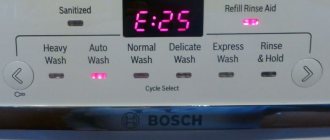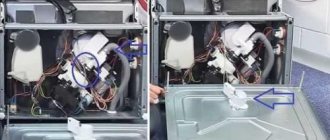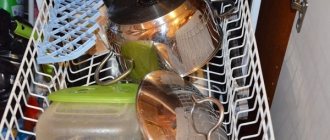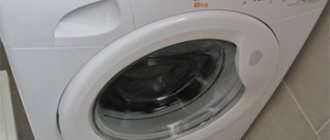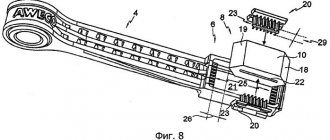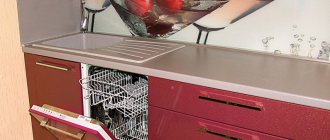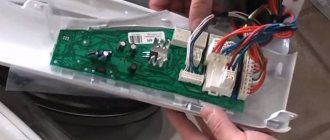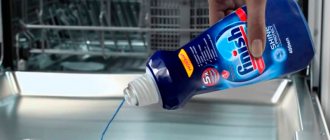Even if you carefully operate the dishwasher according to the instructions, you may encounter the fact that one day the equipment refuses to work. Minor damage can be found and repaired on your own, but in some cases you will have to call a specialist.
In this article we will give the most common causes of breakdowns and discuss how to fix them at home. The repair manual is universal, suitable for all free-standing and built-in models of the following brands: Ardo, Beko, Bosch; Candy / Kandy, Gorenje / Gorenje, Electrolux / Electrolux, Euronova / Euronova, Haier / Haer, Hotpoint Ariston / Hotpoint Ariston, Indesit / Indesit, LG / Eldzhi, Miele / Miele, Samsung / Samsung, Smeg / Smeg, Whirlpool / Whirlpool, Vestel / Vestel, Zanussi / Zanussi, Siemens / Siemens, Neff / Neff, Hansa / Haesa, Aeg / Aeg, Ikea / Ikea, Atlant.
Basic faults
Doesn't turn on
- Faulty wires, plugs, sockets. Damage to the dishwasher wires or plug may cause the dishwasher to shut down or short out. If kinks, breaks or breakage of the fork is detected, they need to be replaced, which you can do yourself or call a specialist. In order to make sure that the outlet is working properly, you need to plug in another device: an iron or a kettle.
- Malfunction of the surge protector located inside the housing. Damage or burning of the contacts in the surge protector leads to the dishwasher turning off, the housing receives an electric current, the plugs “fly out” and the RCD turns off. The element can only be replaced as a whole, it cannot be repaired.
- The buttons on the control panel are broken, do not press, dangle or sink when pressed. It is necessary to disassemble the front panel of the dishwasher and check the bolts and latches on the back side. If the fasteners break and the pushers fly out, the buttons must be replaced or the control module must be reflashed. Repairs cannot be carried out without calling a specialist.
- The control module is faulty - the LEDs do not light up and there is no indication, there is no response to pressing buttons. Most often you have to replace the assembled module; repairing electrical boards is usually not economically feasible, but you can try.
- There is no switching on due to chafing of the wires in the housing. Damage to the wiring inside the dishwasher can cause not only a failure to turn on, but also a short circuit. It is difficult to fix the problem yourself, since the entire equipment must be disassembled.
Does not heat or overheats
- The heating element has burnt out. To check or repair the heating element, you need to turn the device over, remove the back wall and visually check the heating element, having first removed it. We recommend ringing the heating element using a tester. You can replace the element yourself, since it is considered a consumable item.
- The power contacts on the control board are burnt. If the contacts are faulty, the on-board computer of the dishwasher does not transmit the command to heat the water. Sometimes mechanical cleaning of the contacts is enough to restore functionality.
- Problems with the thermostat or temperature sensor. For diagnostics, the disconnected and freed from the baskets PMM is disassembled, dismantling the lower sprinkler and debris filter. The equipment is installed upside down, the side fastenings are removed and the drain pipe is disconnected. When the bottom of the car is raised, the thermostat will be accessible, which is disconnected from the wires. You can test the thermostat and try cleaning the contacts. If the tester shows a breakdown of the temperature sensor, it is replaced. If possible, additionally check the wiring leading to the thermostat.
- If the water overheats, the control unit or temperature sensor is faulty.
Doesn't drain water
- The garbage filter is clogged. Residues from the dishes gradually collect in the filter cavity, preventing normal water circulation. To normalize operation, it is necessary to clean the filter. You can do this yourself.
- The drain pump is jammed or burned out. A characteristic sign is silence when the wash cycle ends and the water starts draining. The part is practically beyond repair and requires replacement entirely.
- If there is the sound of an electric motor running, but the fluid is standing still, large debris has entered the snail pipe. We disassemble and mechanically clean.
Water is not pouring
- Overfill protection is activated. When the dishwasher is empty, the overflow protection sensor may activate, which turns on the drain pump to protect against flooding. It is necessary to disconnect the PMM from the power and water supply, drain the water from the pan and clean the drain filter, dry the dishwasher with a hairdryer or leave it open for several hours. If the problem repeats, you need to call a technician - there may be a malfunction of the pump or pan.
- The inlet valve burned out - a small electromagnetic element that controls the flow of fluid. It burns out due to wear, voltage surges or clogging. Contact in cable connections between parts may also be lost. In this case, it is necessary to call a technician and replace the inlet valve.
Doesn't wash well
One of the most common problems when dishwashers break down is clogged impeller nozzles, or spray arms. If they become heavily clogged, the pressure of the flushing jets is not enough to maintain rotation and the mechanism stops.
The dishes remain dirty on one side. The spray arms are easily removed and washed with a stream of water. More details here.
Stops during operation
- The Aquastop system is activated. Some modern dishwashers are equipped with the Aquastop leak protection system. If water leaks into the dishwasher tray, the drain pump will turn on and stop operation. As a rule, the equipment reports this with a certain code on the display or by flashing indicators. To unlock the PMM, turn off the power supply, remove water from the pan and dry the internal parts of the equipment. After drying, the PMM is restarted; if the problem persists, a technician must be called.
- Another problem could be glitches or failure of the Aquastop sensor itself, which erroneously reports a leak if there is none. In this case, the sensor needs to be replaced.
- The float switch is activated. Modern dishwashers are usually equipped with a float switch to protect against overfilling. If it does not work correctly, it needs to be checked. Remove the front bottom cover, get to the pan and check the float for sticking manually. Tapping helps fix the problem. If this does not help, you need to call a technician and replace the switch.
- If the equipment often does not complete the cycle even after repairing the above-mentioned modules, the main control module is faulty.
Leaking
- Door seals are torn. If the seals are damaged or dry out, the door does not close tightly, causing water to leak from the bottom. Minor damage to the rubber does not affect the operation of the PMM in any way. Repairs are carried out by replacing the upper and then the lower seal. The equipment is disconnected from the network, the door is fully opened, and the loading trays and baskets are removed. The seal is carefully pulled out of the recess. The gutter is wiped with cotton swabs and a dry rag, then a new seal is installed, pushing the rubber bands all the way.
- Broken lock on the door. If there is no characteristic click when the door closes, the lock is most likely faulty. The door does not close tightly, causing water to leak. A breakdown should be accompanied by an error code with a corresponding indication in the form of an icon, which does not always happen. To replace the lock, de-energize the device, remove the facade and control panel, unscrew the lock and replace it with a new one.
- The door or fastening to the body is deformed. If used carelessly, the door fastening bracket can be deformed, a couple of degrees not noticeable to the eye, enough for the rubber band to begin to let water through. For diagnostics, the door is visually inspected for the presence of dents or loose fit to the PMM. We recommend replacing the mount with a new one.
The door won't close
- The lock is broken. The door does not hold or lock in the closed position. The lock can jam even when the door is open, which will not allow the PMM to be hermetically sealed. You can solve the problem one-time using a screwdriver by wedging the lock tongue, but it is better to completely replace the latch element.
- When opened, the door suddenly “falls out”. Most likely, the cable or the tensioner itself (2 small springs) broke. You can replace the tensioners yourself, but you will have to disassemble the housing. During self-repair, the old cable and spring are replaced with new ones, preferably original ones.
Burnt out intake or exhaust valve
- The inlet valve is burnt out. If the inlet valve fails, the PMM will not take in water, the part will not respond to controller commands, or, conversely, will not ensure closure of the membrane. The equipment is disconnected from the network and water supply, the bottom or base panel is removed, and the reservoir with the hose is disconnected. The reservoir is opened and the inlet valve is replaced. In some machines you won’t be able to do this yourself; you need to call a technician.
- The water discharge recirculation valve has burnt out (usually installed on expensive models, such as Bosch). If the outlet valve fails, water does not leave the PMM, error e19 lights up on the panel. The part requires replacement.
Debris gets into the main motor
If debris gets into the high-pressure motor (pump), the machine will make a characteristic noise, grinding, whistling, and the electric motor may jam, causing a hum. A burning smell appears and fuses trip. This happens due to loading dishes into the PMM that are contaminated with large food debris, such as seeds from berries and fruits. We take out the module and try to wash it, it usually helps.
The pressure switch (water pressure sensor) is broken
- The pressure sensor is broken. If the pressure sensor breaks down, continuous circulation of water occurs, there is no heating and automatic, continuous drainage of the liquid occurs. The problem can only be solved by replacing the sensor.
- When the air tube connecting the water tank and the sensor is clogged, water overflow or underfill occurs. The part requires removal and mechanical cleaning.
The turbidity sensor is clogged
A turbidity sensor, or aquasensor, allows equipment to “understand” how well the dishes have been washed by assessing the light conductivity of the water. If the surface of the aquasensor becomes clogged, the machine automatically extends the cycle without completing the wash and increases water consumption.
- If the sensor is covered with grease, you can disassemble the equipment and degrease the sensor.
- The sensor may become clogged due to salt deposits (scale) - take a screwdriver and “pick out” the hard white crust.
If mechanical cleaning does not help, we replace the module ourselves or call a technician.
No grounding
- The surge protector that protects electrical circuits from burning during power surges is broken. Damage or weakening of the contacts in the surge protector causes “glitches” in the control module, causing incorrect operation, and ultimately leading to equipment shutdown. Also, a malfunction of the SF leads to an electric shock through the housing.
- The body is electrocuted. It is necessary to fix the outlet or connect the PMM to another outlet equipped with grounding. The socket for connecting the dishwasher must be connected to the circuit breakers using a three-wire wire.
- Knocks out the circuit breaker or RCD. If there is no grounding, the circuit breaker may be knocked out due to spurious interference. Another reason may be inappropriate, old electrical wiring that requires replacement.
Doesn't dry out
- The thermal fuse of the air heating element trips. The problem appears over time when the condensation dryer housing overheats. The thermal fuse needs to be replaced, most often together with the dryer module.
- The air heating element has burned out. If the heating element fails, a burning smell may appear. A part needs to be replaced.
- The warm air circulation motor has burnt out. The problem occurs when there is a power surge, a dirty air filter, and often appears in conjunction with a broken mains filter. The assembly is changed or the winding is rewound (rarely helps and is not cost-effective).
Hoses become clogged
Do not place dishes that are excessively soiled with food debris into the dishwasher. All fat, bones and other biological residues accumulate in the pipes and hoses. To eliminate the problem, the PMM is disassembled and the hoses are cleaned manually.
Sprinkler does not spin
- Impeller clogged. Remove the nozzles and rinse the nozzles in the opposite direction under running water.
- Loss of tightness. If the impeller loses its tightness, water can fly out into the gaps that appear. Sprinklers need to be replaced.
- The secondary plastic gasket has worn out. It is necessary to remove the impeller and replace the gaskets.
- High pressure pump malfunction. If the nozzles are OK, you need to inspect the pump. If the motor hums but does not rotate, the problem is most likely in the pump. Disconnect the machine from the network, open the case, loosen the pipe clamps and disconnect the connectors. Release the latches and unscrew the mounting screws. Next, release the fastenings of the other pipes, move them to the sides and remove the pump from the housing. Now install the new motor and reassemble the structure in reverse order.
How does a dishwasher work?
There are a number of standard operating modes, each model is equipped with a pair of specific ones. But the approximate algorithm is similar. The dishwasher draws water using a central network. The intake goes through the salt softener overflow. The brine compartment is usually located in the floor of the dishwasher, covered with a lid.
The flow enters under its own pressure, bypassing the inlet filter, and is regulated by a float valve or pressure switch. The required amount of water has filled the dishwasher - the supply channel is closed and heating begins.
Depending on the technological stage of the cycle, the required temperature is different. For the last rinse, the value is traditionally increased. Designed to facilitate the process of drying dishes.
The heated water is pumped by the main pump (the unit is called a pump) into the working chamber. It gets there through sprinklers equipped with sprinklers. A thoughtful choice of the direction of the beating jets creates a reactive force that rotates the impeller. The dishwasher has two spray arms - lower and upper. The design has no fundamental differences.
Waste water goes through two stages of purification, bypassing filters, and is then reused for washing. During the process described, a small amount of powder is introduced into the chamber through the door of the detergent tray. The exact quantity is set by the program. The dishwasher uses water several times, cleaning the flow with two filters, and at the end of the technological stage it sends it to the drain with a special drain pump.
At the end of the cycle, drying is carried out. There are several types of procedure, mainly:
- condensation drying;
- turbo drying
In the first case, the dishes dry due to the heat generated by the last rinse; steam condenses on the cold walls and flows down. The process is catalyzed by special substances contained in the rinse aid, which reduce the surface tension of water. In dishwashers equipped with a turbo dryer, hot, humid air is forced out by a fan, speeding up the process.
It was mentioned above how washing powder, gel, and tablets get into the compartment. The rinse aid is poured into a separate container; in some cases, it may not be involved in the process at all. The cycle looks like this:
- pre-wash;
- main wash;
- rinsing;
- drying.
It remains to be mentioned that for washing the dishes are placed in special baskets and lie motionless during the cycle. Jets of water pour from all sides due to the rotation of the sprinkler impellers. Below are a kind of dishwasher repair guide and practical tips for monitoring the correct operation of the equipment.
"Weak points" of famous brands
Every technology has its weaknesses, no matter how advanced the company and its products are.
Electrolux
- problems with water supply and drainage;
- heating systems;
- electronics;
- impellers;
- leaks.
Hotpoint-Ariston
- "Aquastop" system;
- heating elements;
- pressure switch;
- valves
Bosch
- "Aquastop" system;
- Launchpad problems;
- clogged filters;
- circulation pump;
- hatch lock.
Prices
It is, of course, difficult to name the exact cost of repairs before a technician diagnoses a faulty dishwasher. But the table below will help you roughly calculate the costs of upcoming repairs.
| Type of work | Cost* (work only) | Cost* (work only) | Operating time, minutes | Guarantee |
| Visit of the master | For free** | For free** | In 24 hours | — |
| Diagnostics | For free** | For free** | 10-40 | — |
| Dismantling + installation of built-in equipment | from 700 rub. | from 700 rub. | 10-30 | — |
| SMALL REPAIR | ||||
| Cleaning filters | from 1300 rub. | from 1300 rub. | 15-30 | — |
| Cleaning the filler mesh filter | from 1000 rub. | from 1000 rub. | 15-30 | — |
| Replacing the drain hose | from 1500 rub. | from 1500 rub. | 20-40 | from 1 to 2 years |
| Replacing the inlet hose | from 1000 rub. | from 1000 rub. | 10-20 | 1 year |
| Replacing the inlet hose with the Aquastop system | from 1300 rub. | from 1300 rub. | 15-30 | 1 year |
| Replacing the power cord | from 1200 rub. | from 1200 rub. | 20-40 | 1 year |
| Replacing the lower door seal | from 1200 rub. | from 1200 rub. | 20-30 | 6 months |
| Replacing the U-shaped door seal | from 1800 rub. | from 1800 rub. | 20-40 | 6 months |
| Replacing a button | from 1000 rub. | from 1000 rub. | 30-50 | 6 months |
| Replacing the control sensor | from 1300 rub. | from 1300 rub. | 30-60 | 6 months |
| Replacing basket wheel holders (1 pc.) | from 100 rub | from 100 rub | 5-10 | 6 months |
| Replacing basket wheels (1 pc.) | from 100 rub | from 100 rub | 5-10 | 6 months |
| Repair or replacement of door hinge (1 pc.) | from 1200 rub. | from 1200 rub. | 20-30 | 6 months |
| Replacing the salt sensor | from 1300 rub. | from 1300 rub. | 20-30 | 3 months |
| Repair or replacement of door spring (1 pc.) | from 1400 rub. | from 1400 rub. | 20-30 | 6 months |
| Lock mechanism repair | from 1400 rub. | from 1400 rub. | 20-40 | 1 year |
| Repair or replacement of detergent dispenser (dispenser) | from 1400 rub. | from 1400 rub. | 20-40 | 1 year |
| Cleaning the sprayer (impeller) (1 pc.) | from 1000 rub. | from 1000 rub. | 10-20 | 3 months |
| Replacing the sprinkler (impeller) (1 pc.) | from 900 rub. | from 900 rub. | 5-10 | 6 months |
| Adjusting the pressure switch (water level switch) | from 1300 rub. | from 1300 rub. | 20-30 | 3 months |
| MEDIUM REPAIR | ||||
| Replacing the heating element | from 1900 rub. | from 1900 rub. | 30-60 | 6 months |
| Replacing the drain pump | from 1700 rub. | from 1700 rub. | 30-70 | 6 months |
| Replacing the circulation pump | from 2400 rub. | from 2400 rub. | 40-70 | 6 months |
| Repair of the circulation pump (repair kit) | 3 months | |||
| Unlocking the circulation pump | from 2000 rub. | from 2000 rub. | 40-70 | — |
| Finding and eliminating blockages in the drain tract | from 1500 rub. | from 1500 rub. | 20-70 | — |
| Replacing the door lock (UBL) | from 1800 rub. | from 1800 rub. | 30-60 | 1 year |
| Replacing the pressure switch (level sensor) | from 1700 rub. | from 1700 rub. | 40-60 | 6 months |
| Replacing the filling valve (KEN) | from 1600 rub. | from 1600 rub. | 30-60 | 6 months |
| Replacing the control or display unit | from 2300 rub. | from 2300 rub. | 30-80 | 1 year |
| Repair of control or indication board | from 2700 rub. | from 2700 rub. | 40-90 minutes on site or 2-3 days (taken to the workshop) | 6 months |
| Replacing the starting capacitor of the circulation pump | from 1600 rub. | from 1600 rub. | 30-60 | 1 year |
| Replacing the flow meter (water flow sensor) | from 1800 rub. | from 1800 rub. | 30-40 | 6 months |
| Replacing the turbidity sensor | from 2100 rub. | from 2100 rub. | 30-40 | 6 months |
| Repair of the heat exchanger (cleaning, replacement of the drain valve, etc.) | from 2300 rub. | from 2300 rub. | 40-80 | 6 months |
| Replacing a flow-through heating element (heating element) | from 2200 rub. | from 2200 rub. | 30-60 | 1 year |
| Replacing the salt tank | from 2100 rub | from 2100 rub | 40-70 | 1 year |
| Replacing the control panel | from 1600 rub. | from 1600 rub. | 30-40 | 2 years |
| Repair of the washing tank glass (repair kit) | from 1800 rub. | from 1800 rub. | 30-40 | 1 year |
| Repair or replacement of the leakage protection system (Aquastop) | from 2000 rub. | from 2000 rub. | 30-90 | 1 year |
| Repair or replacement of pipe | from 1800 rub. | from 1800 rub. | 30-40 | 1 year |
| Replacing the temperature sensor or thermostat | from 1700 rub. | from 1700 rub. | 30-60 | 6 months |
| Electrical wiring repair | from 1500 rub. | from 1500 rub. | 40-80 | 2 years |
| COMPLEX REPAIR | ||||
| Replacing the water intake (crankcase) | from 2500 rub. | from 2500 rub. | 1 - 1.5 hours | 1 year |
| Replacing the volute (sump bowl) of the circulation pump | from 3500 rub. | from 3500 rub. | 1-2 hours | 1 year |
| Replacing the washing tank | from 3500 rub. | from 3500 rub. | 2-3 hours | 1 year |
| DISCOUNTS (only for labor, spare parts and components do not apply) | ||||
| For pensioners | 10% (presentation of passport or pension certificate is required) | |||
| Low-income citizens | 5% (presentation of a social card is required) | |||
* The price is indicated only for the work of the master, excluding the cost of spare parts. The full cost will become known only after diagnosis.
** Payment for diagnostics will not be required if you agree to repair by a RemBytTech specialist.
Recommendations and lifehacks
- Clean dishes from food residues before loading them into the PMM.
- Load the upper basket with small, not heavily soiled dishes.
- Load the lower basket with the dirtiest dishes.
- Start unloading dishes after drying from the bottom section.
- Do not overload the PMM.
- Carry out preventive cleaning of parts regularly - at least once every 3 months.
- Use professional dish degreasing products.
- Do not overuse short wash cycles.
FAQ
How to stop the program and unlock the door
Canceling a program is most often done by pressing the “Start” key and holding it for 3 seconds. After stopping the program, the machine will drain and unlock the door.
If the water is turned off and the process is running
We recommend disabling PMM as soon as possible to avoid program failure.
Why does the tablet fall out?
Incorrectly selected tablet, you need to change the brand. It is also necessary to check the operation of the dispenser.
Required pressure
Each equipment has its own operating pressure (standard 1.5-2 atmospheres), determined by technical parameters. In city water supply there is usually from 0.3 to 6 atmospheres for cold water and from 0.3 to 4.5 atmospheres for hot water. To get acquainted with information on a certain PMM, you need to study its passport.


